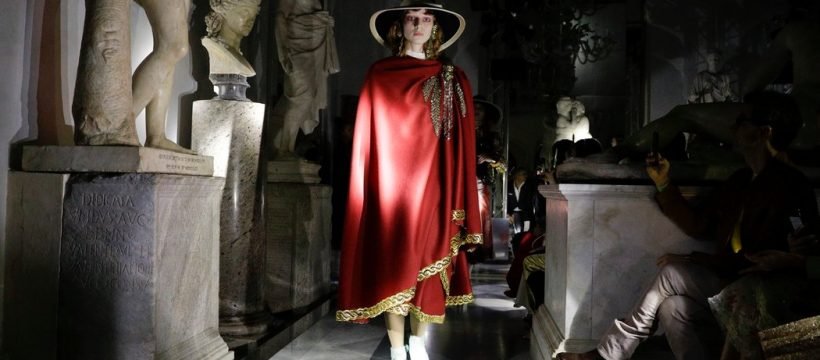ROME — The sky was black, with ominous clouds overhead. Almost 500 guests sheltered inside the renowned Capitoline Museums (widely considered the first museum in the world where art could be enjoyed by all, not just the elite) on Tuesday, waiting for the Gucci 2020 cruise collection.
There was just one problem: They couldn’t see a thing. The long frescoed galleries of the Capitoline were shrouded in darkness.
And so they went, stumbling through its blacked-out marbled hallways along with fellow guests like Elton John, Zoe Saldana and Saoirse Ronan. Eventually, they found that a small flashlight had been left on each mirrored cube of a seat.
“My work sometimes is like being an archaeologist. I discover things. Using a torch to find things that hide in darkness,” Alessandro Michele, Gucci’s creative director, said by way of explanation, looking a little tired with his beard and a black velvet hat. “With it in your hand, you can decide what to see and on what treasures you can shine your light.”
It was all a metaphor! And what, exactly, did Mr. Michele want illuminated?
Perhaps the fact that his ongoing practice of mining history, ancient cultures and religions with his magpie eye produced Gucci’s first quarter 2019 sales of €2.3 billion ($2.57 billion), up 20 percent from the same period a year earlier. Or perhaps that he is a loyal son of Rome, born here in 1972 and raised on its museums and churches. Perhaps it was that the show was his first in the city for Gucci (although he already has moved the house’s design headquarters here), and thus a triumphant homecoming of sorts.
“It was very important to me to organize this show in Rome,” he said after the show. “To pay tribute, and to glorify this place of freedom. Rome is a big womb and many things have come out of it. I will disappear one day, but this city will always remain.”
This latest collection was not just another sprawling homage to the glories of the ancient past. As the models emerged, some with “Gucci” tattoos inked like gags across their mouths, it was, Mr. Michele declared, also a loud rallying cry for freedom of self-expression. Specifically, for women’s sexual and reproductive health and rights.
“Nobody should have the right to decide about the freedom of choice of any human being,” Mr. Michele said. “The news I recently read in the newspaper made me reflect on the fact that women have to be respected. They should be considered as some men consider themselves, and be free to choose what they want.”
And so the models came, in everything from a billowing gown embroidered with an outline of the female reproductive system and embellished with pink flowers, to lace cycling shorts, furry wraps and fishnets. There were T-shirts and jackets bearing the slogans “my body my choice,” or “May 22, 1978,” when abortion was first legalized in Italy. Also, in a wry subversion of patriarchal power dressing favorites, a sweeping imperial scarlet cape embroidered with gold leaves, as well as a series of black papal cassocks, trimmed in fake fur.
Mr. Michele’s Gucci has always been about a flamboyant and occasionally profound conversation with the zeitgeist, drawing from it, adding to it, sometimes even altering the way the fashion world sees value, gender and identity. Sometimes that chatter can miss its mark, like in February, when the brand apologized for a $890 women’s balaclava sweater, widely denounced on social media as evoking blackface imagery.
However this collection, coming in the wake of recent events in Alabama and anti-abortion activity in other states — felt more convincing and personal in its intentions than most.
That may be why, despite his clear statement about choice, Mr. Michele also went on to mix messages.
Alongside women’s rights, he included men's wear looks that included a toga draped across a gray plaid suit, shell suits in Gucci’s hallmark green, black and red palette and some lilac Liberty prints. The boys’ choices also included a series of long and short dresses in rich brocade or Mickey Mouse motifs, an encore of the continuing Gucci movement toward a more genderless, seasonless kind of self-determination.
The drumbeat to it all was a familiar paean to the freedom and liberation of the 1970s — a crucial decade for women’s liberation. Here it came in the form of brocade and plaid suiting, beaded ruffle skirts and wide-brimmed hats; also corduroy flares, oversized eyeglasses, printed guitar cases and romantic silk dresses with kerchief hems and billowing sleeves.
In case you missed the point, several hours later the cult ’70s heroine Stevie Nicks, wearing a black corset and lace gloves, took to the stage at the boozy, slightly rain-soaked after-party to serenade the crowd. Later — because for Mr. Michele, if one thing is good, two is better — Gucci’s favorite poster boy, Harry Styles, also appeared, sporting a white tuxedo and pastel nail polish, for a final triumphant duet of “Landslide.”
Then, using the light of their cellphones, the Gucci gang dispersed into the shadows, and off into the night.
Elizabeth Paton is a reporter for the Styles section, covering the fashion and luxury sectors in Europe. Before joining The Times in 2015, she was a reporter at the Financial Times both in London and New York. @LizziePaton
Source: Read Full Article
